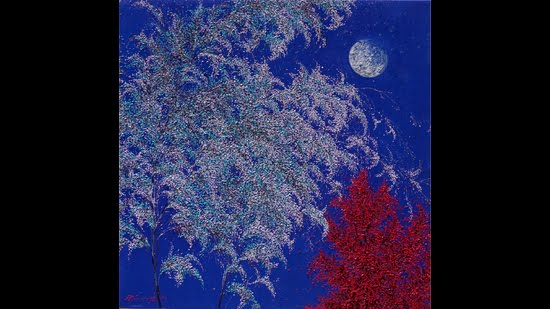Himalaya Harbinger, Rudrapur Bureau
A century later, artist Pardeep Singh put on display his oil-on-canvas work, ‘Moonlit’, to convey his impressions of a tree whose leaves are flickering a silvery hue in the celestial beams of the night. “My paintings convey what a poet says through words. ‘Moonlit’ endeavours to capture the essence of moonlight, the mystery of the night and how it leaves an impression on my mind,” Singh told this writer.
Moonlit is one of several tree artworks by Singh on display at the Government Museum & Art Gallery till March 2, 2025. His solo exhibition, ‘Rooted Reflections’, has been staged under the aegis of the AIM Gallery.
An artist who earned his degrees from Santiniketan’s Visva-Bharati University, Singh’s impressionist paintings take the viewer through an odyssey of seasons and regions. His is not art for art’s sake. Singh is an activist. He aims to engage the viewer, to draw him / her into “his world of artistic interpretations, and not be reduced to a mere onlooker…to entice the viewer and evoke a response as they become one with the painting.”
Art cannot change the world but it can change thinking. I desire that people emotionally connect with trees via my art. Just as people care for their children because they have an emotional connect. Chandigarh has so many trees that citizens are virtually spoilt for choice. But look at other cities, they are soulless and virtually devoid of trees. By making people relate to trees and visualising their different forms, my art intends to make them care for trees. Once that happens, caring, sensitised people will act to protect trees,” added Singh.
Devotees of the sweet goddess
Some of the most vivid moments of flora changing hues (or clothes!) is to be witnessed in late February and March. The one of jungle dominance is the Semul (silk cotton tree) that stands like a red tower with its cup-full blooms of waning vermillion or Valentine red.
The tree beckons as a sky restaurant offering nectar for birds, honey bees, ants and other insects. Semul flowers also radiate a mild but esoteric scent, which is difficult to ‘grasp with the human nose’ or evoke with comparison to a familiar fragrance.
Photographers focus on birds that riddle the Semul’s boughs but there are some mammals less noticed in the carnival of nectar. At night, fruit bats visit Semul flowers for an ‘after 8’ nectarine drink while monkeys clamber aboard the tree during daytime to eat flowers
On the ground below, the fallen blooms scatter like blobs of red on undergrowth that is tawny and pale green, and weary with winter’s dreary passage.The jungle floor suddenly transforms with Semul blooms, like a joyous dispersal, a throw of colour. It is nature’s trailer to the impending play of Holi, the festival of colours.
On the ground, four-legged creatures await their turn, eyeing the rain of luscious, sweet flowers. In particular, I observed Sambars relishing the flowers in the Shivalik foothill jungles and at the Nature Trail running behind the Sukhna lake. The Hog deer (Parha) also relishes Semul blossoms as a proverbial ‘gulab jamun’ treat, almost child-like in happiness.










